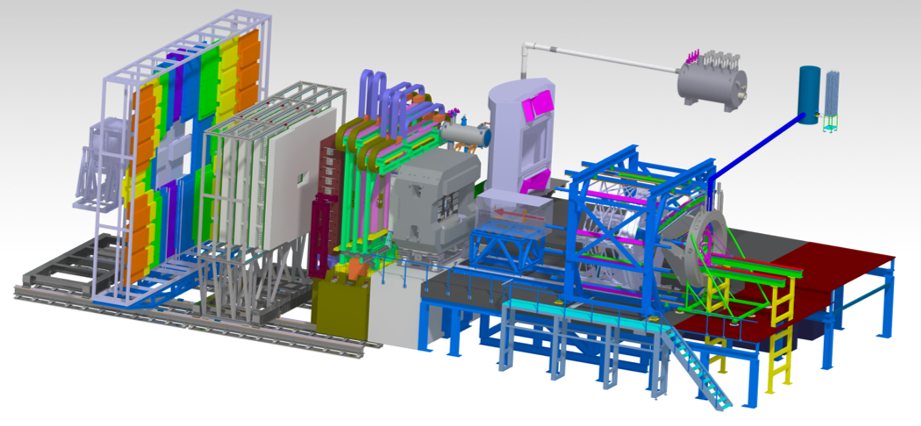The research program on dense QCD matter at FAIR will be performed by the experiments CBM and HADES which are shown in figure 1. The two setups will be operated alternatively. The HADES detector, with its large polar angle acceptance ranging from 18 to 85 degrees, is well suited for reference measurements with proton beams and heavy-ion collision systems with moderate particle multiplicities, such as Ni+Ni or Ag+Ag at low SIS100 energies. With the HADES detector, electron-positron pairs and hadrons including multi-strange hyperons can be reconstructed.

The CBM setup is a fixed target experiment which will be capable to measure hadrons, electrons and muons in heavy-ion collisions over the full FAIR beam energy range. In a central collision of two gold nuclei at FAIR energies, about 700 charged particles are emitted. The tracks of these particles will be measured by a Silicon Tracking System (STS) consisting of 8 layers of double-sided micro-strip sensors located in a magnetic field of a superconducting dipole magnet. The identification of hadrons requires an additional time-of-flight (TOF) measurement, which is performed by a wall of Multi-Gap Resistive Plate Chambers with an active area of about 120 m2 located about 7 m downstream the target. A Micro-Vertex-Detector (MVD), consisting of four layers of silicon monolithic active pixel sensors located in front of the STS, provides high-precision information of secondary decay vertices of short-lived particles like of open charm mesons.
The identification of electrons and positrons is performed by a Ring Imaging Cherenkov (RICH) detector and a Transition Radiation Detector (TRD). Muons will measured by a Muon Chamber (MUCH) system which consists of Gas Electron Multiplier detector triplets sandwiched between hadron absorber plates made of graphite and iron. For muon measurements, the RICH detector will be replaced by the MUCH, and the TRD serves as tracking detector after the last hadron absorber. The reaction plane angle of the collision will be measured with the Project Spectator Detector (PSD), which is a segmented hadronic calorimeter located 10-15 m downstream the target.
In order to perform high precision measurements of rare diagnostic probes, the CBM experiment will be operated at collision rates up to 10 MHz, leading to data rates up to 1 TB per second. To achieve the required performance, a free-streaming, trigger-less Data Acquisition System (DAQ) is under development. All detector signals are readout by ultra-fast and radiation-tolerant ASICs as front-end chips, which mark each hit with a time stamp, and send it to CERN GBTx-based radiation-tolerant data aggregation units. Further down-stream, the data streams are handled by Common Readout Interface (CRI) boards containing powerful FPGAs, and are forwarded via a PCIe based FPGA board to the entry node of a large-scale computer farm, the First-Level Event Selector (FLES). Finally, the data are transmitted via a high-speed optical connection (InfiniBand) to the FLES processing nodes, which are located in the high-performance computing center of GSI, the GreenIT cube. Upon reception in a FLES processing node, the micro-slices originating from all active subsystems, i.e the detector hits with time stamps collected over about 100 ms, are grouped into larger time-slices of about 100 ms, containing information from all detector systems. These time-slices then are used for the online data reconstruction and selection.
In order to perform a full system test of the CBM data readout and acquisition chain, the miniCBM (mCBM) experiment has been installed at SIS18. The mCBM setup comprises final prototypes and pre-series components of all CBM detector subsystems and their read-out systems. The setup allows the commissioning of the free-streaming data acquisition system, the data transport to the high performance computer farm inside the GreenIT Cube, the online track and event reconstruction and event selection algorithms. In addition, high-rate detector tests will be performed with nucleus-nucleus collisions under realistic experiment conditions up to interaction rates of 10 MHz.
Detailed information on the various hardware and software developments towards the realization of the CBM experiment is presented in the CBM Progress Report 2019 (link).


